Design of microstrip patch antenna for 5G wireless communication applications
The purpose of this paper is to design and simulate a microstrip planar antenna for the
future-fifth generation (5G) wireless applications. The antenna structure is built on a low loss
RO3003 substrate of 3.0 relative permittivity and fed by a 50 Ohms microstrip line. The
proposed antenna provided a high gain of 5.51 dB at 28 GHz (gigahertz) bands, with a
minimum reflection coefficient of -24.3 dB, a very wide bandwidth of 2.5 GHz and the
radiation pattern was mostly omnidirectional. The thickness of the substrate has been changed,
the resonant frequency can be at 20/28 GHz or 20/38 GHz depending on the value of thickness,
which both are the proposed bands for 5G. In this paper, all simulations have been using
industry-standard software CST Microwave Studio.
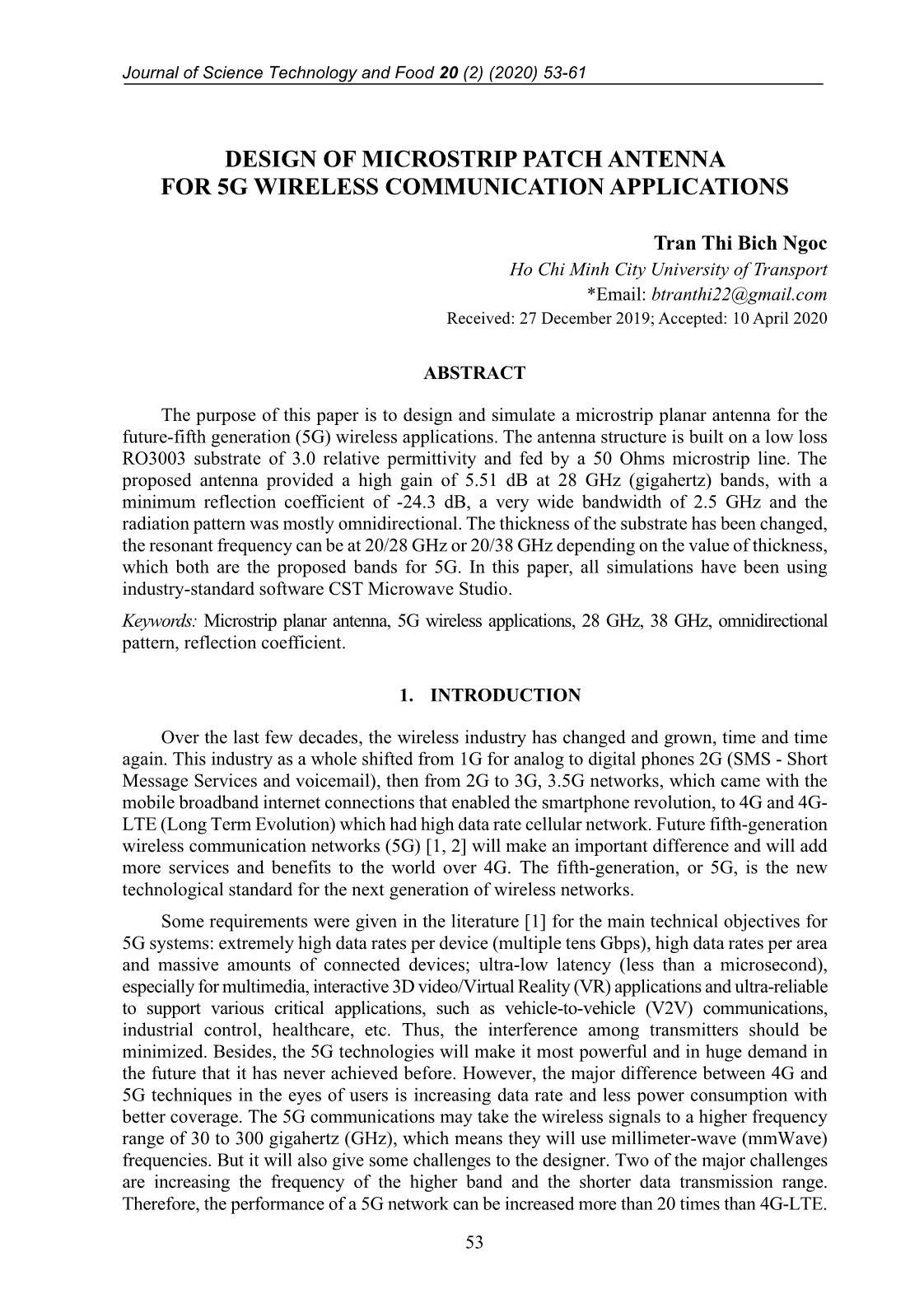
Trang 1
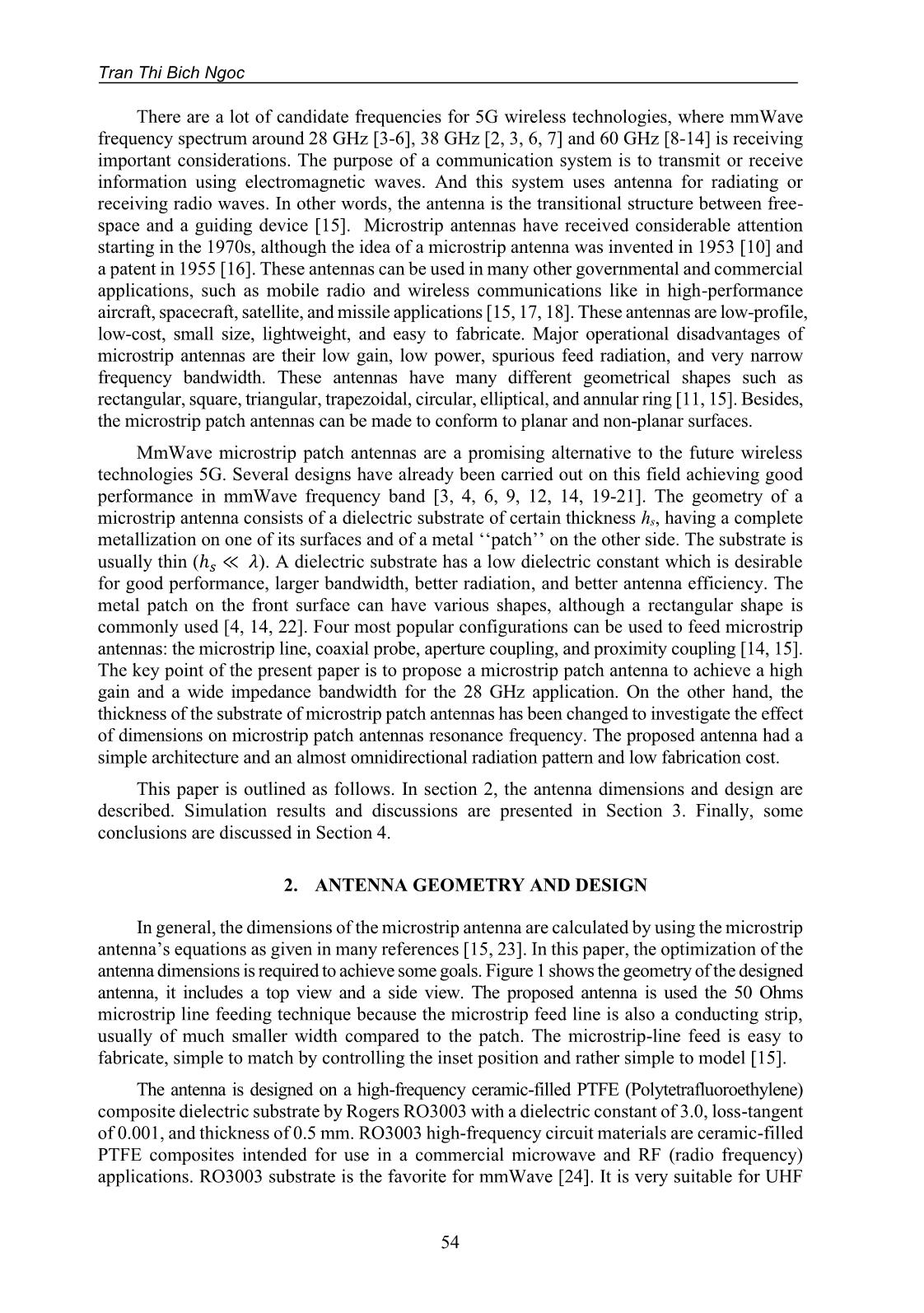
Trang 2
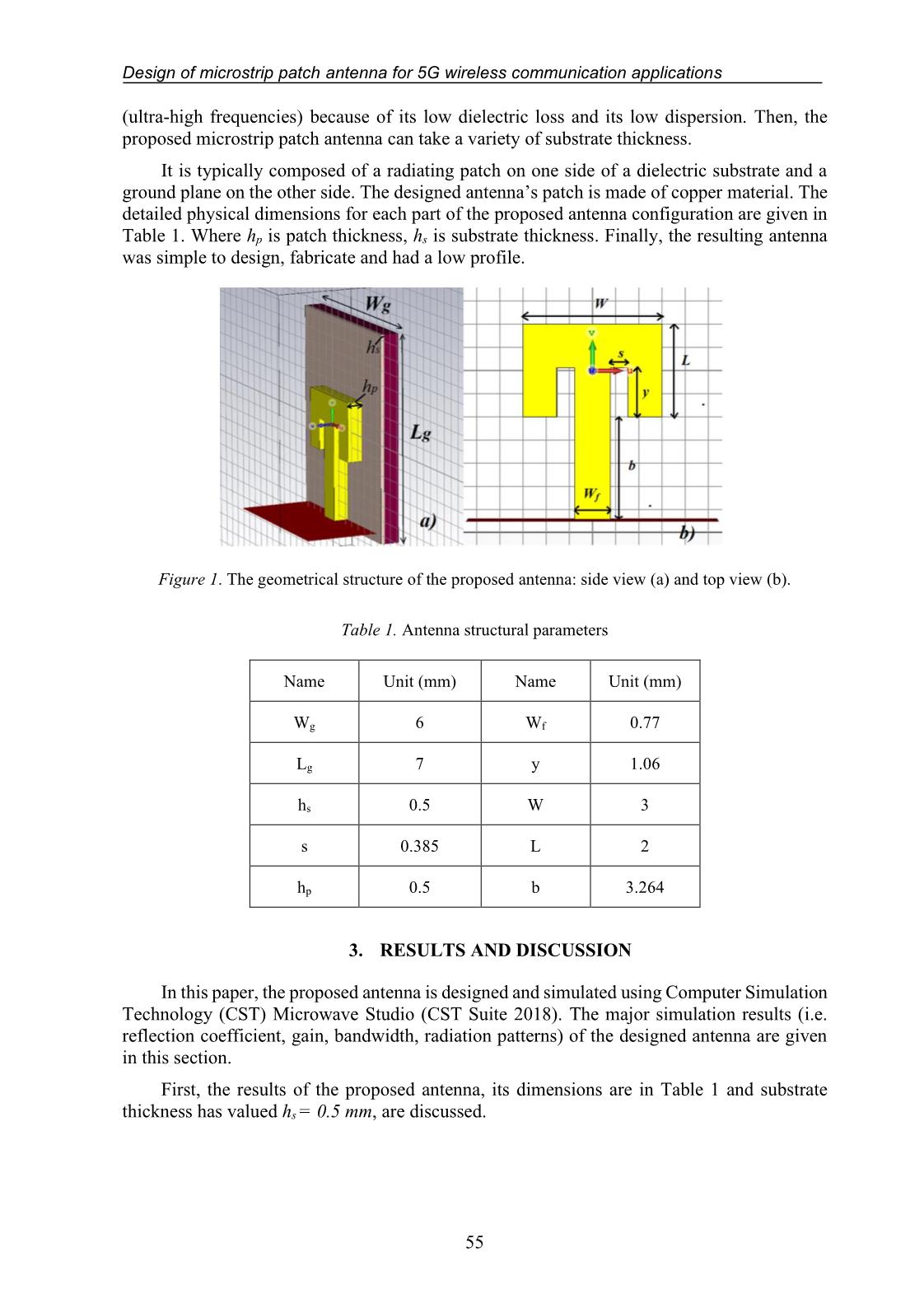
Trang 3
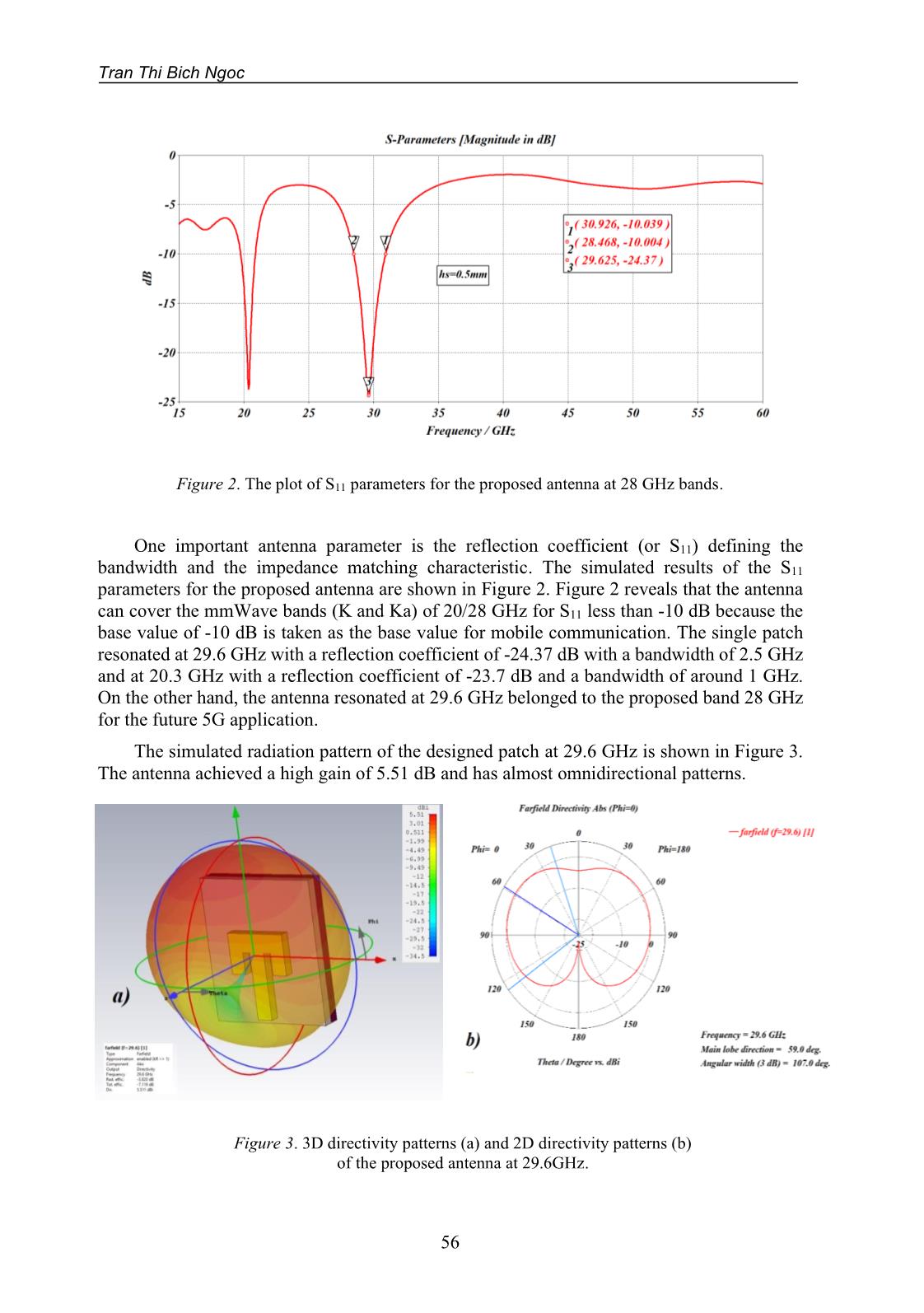
Trang 4
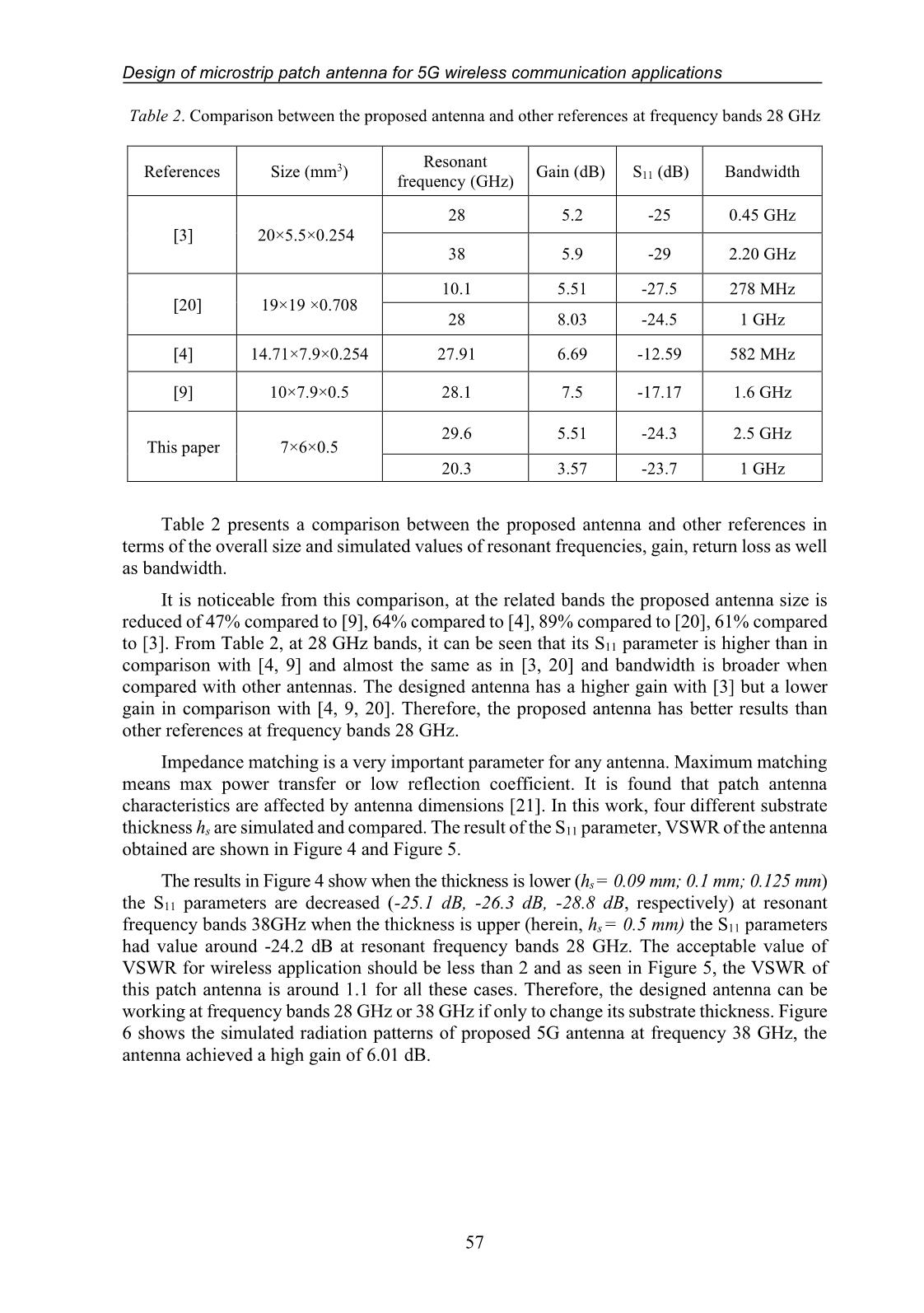
Trang 5
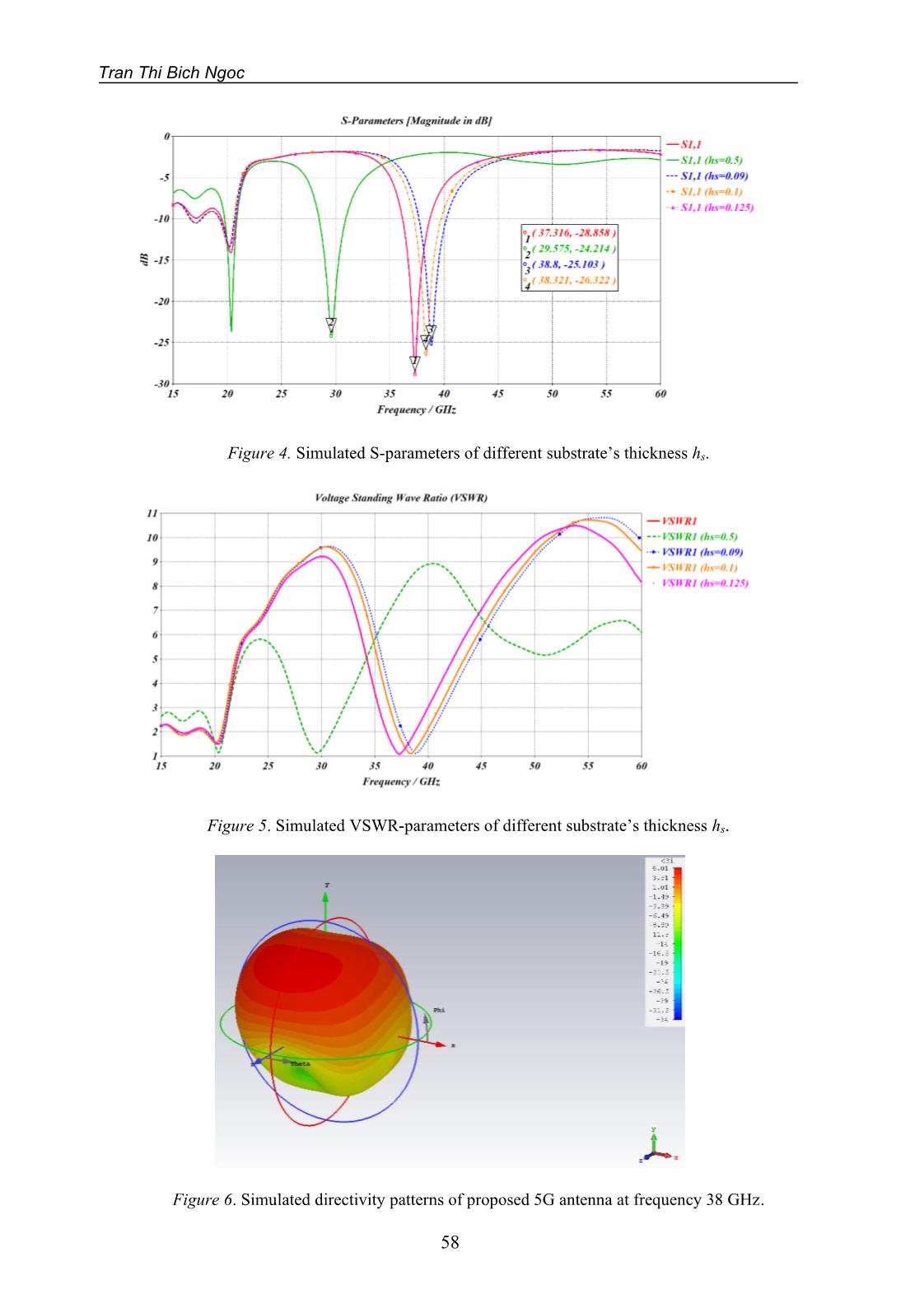
Trang 6
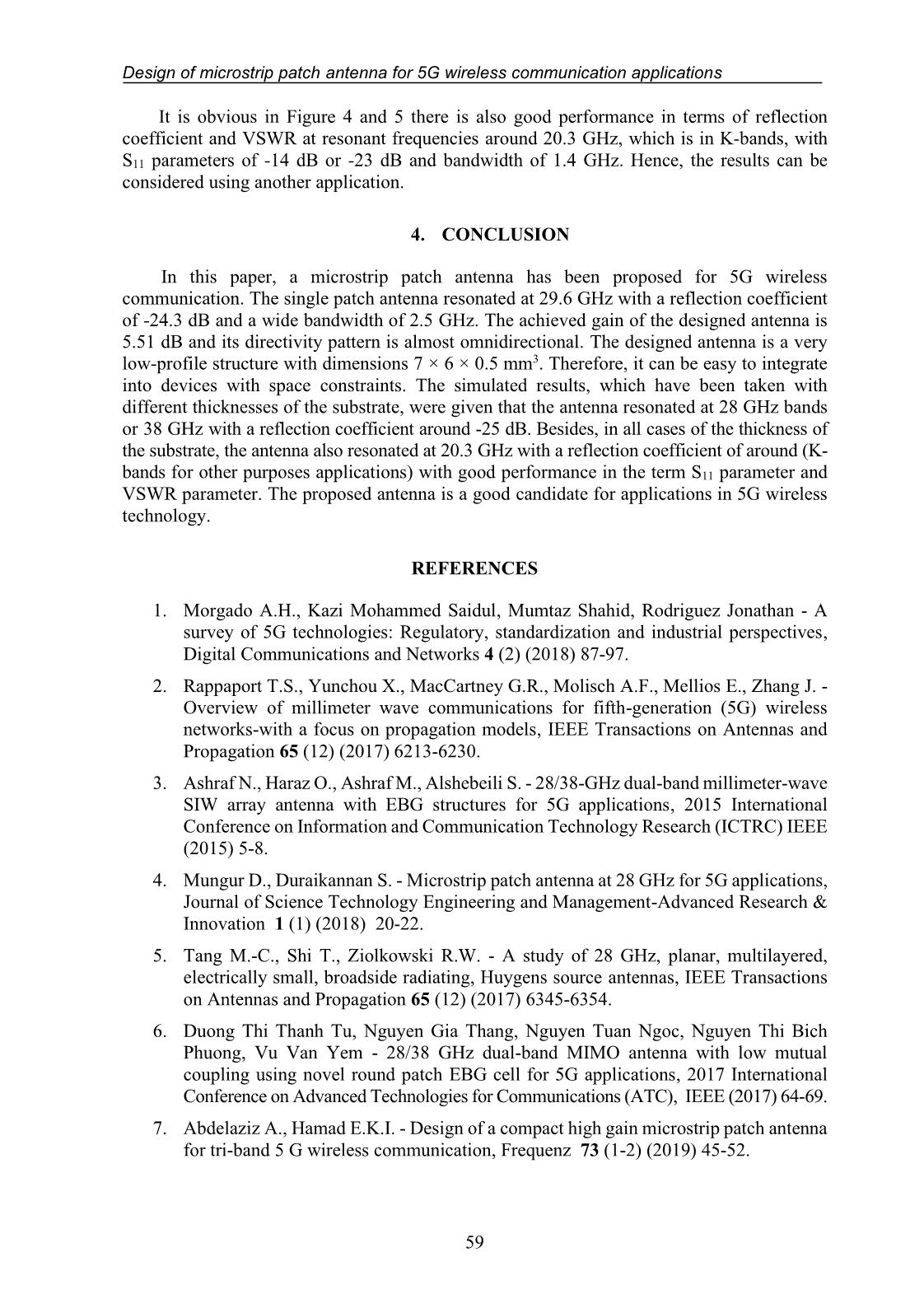
Trang 7

Trang 8
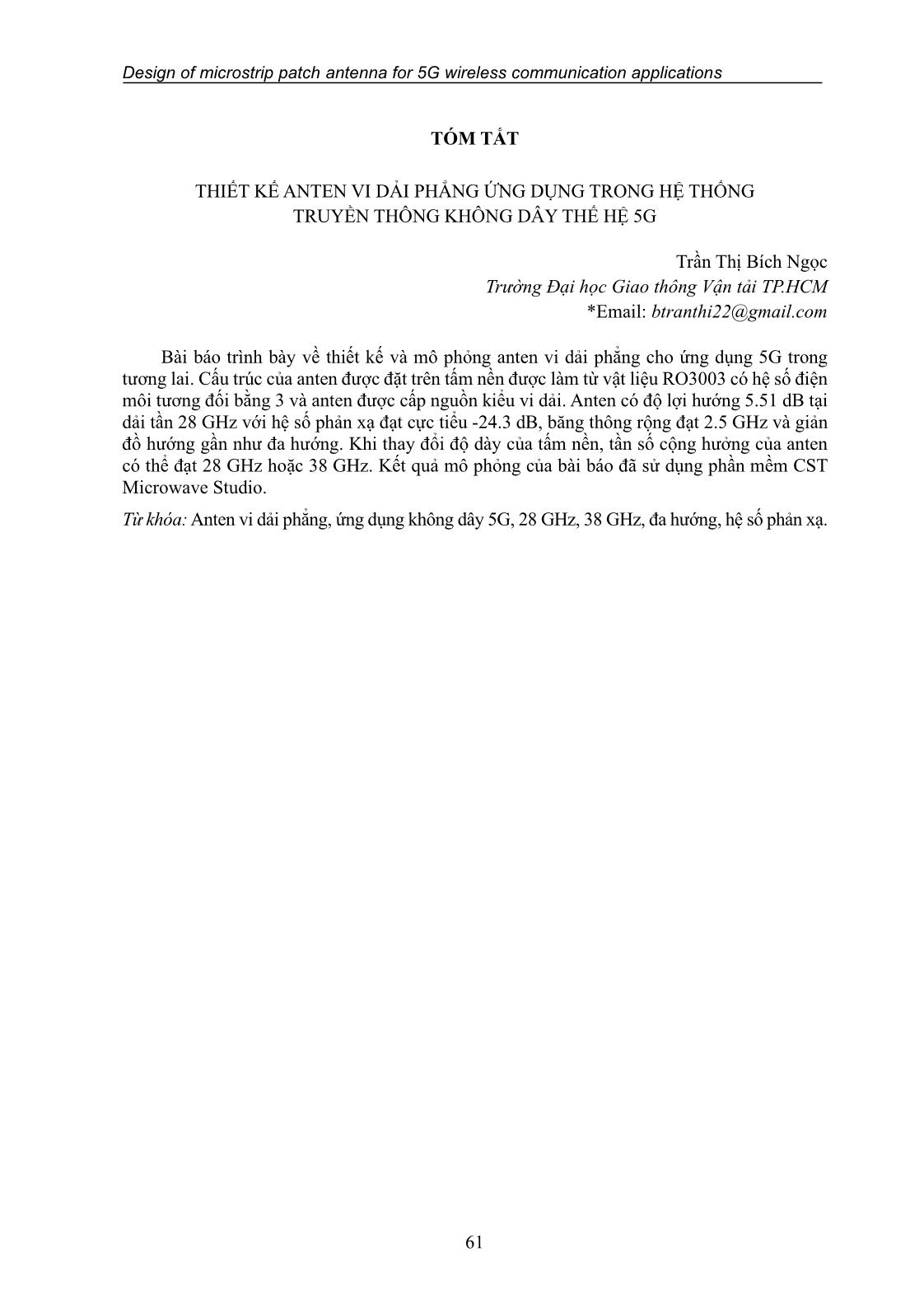
Trang 9
Tóm tắt nội dung tài liệu: Design of microstrip patch antenna for 5G wireless communication applications
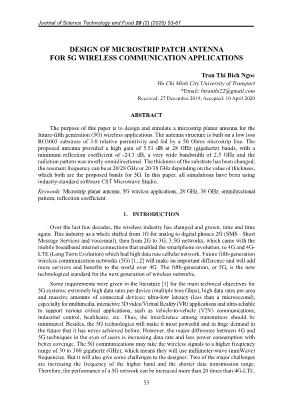
substrate has a low dielectric constant which is desirable for good performance, larger bandwidth, better radiation, and better antenna efficiency. The metal patch on the front surface can have various shapes, although a rectangular shape is commonly used [4, 14, 22]. Four most popular configurations can be used to feed microstrip antennas: the microstrip line, coaxial probe, aperture coupling, and proximity coupling [14, 15]. The key point of the present paper is to propose a microstrip patch antenna to achieve a high gain and a wide impedance bandwidth for the 28 GHz application. On the other hand, the thickness of the substrate of microstrip patch antennas has been changed to investigate the effect of dimensions on microstrip patch antennas resonance frequency. The proposed antenna had a simple architecture and an almost omnidirectional radiation pattern and low fabrication cost. This paper is outlined as follows. In section 2, the antenna dimensions and design are described. Simulation results and discussions are presented in Section 3. Finally, some conclusions are discussed in Section 4. 2. ANTENNA GEOMETRY AND DESIGN In general, the dimensions of the microstrip antenna are calculated by using the microstrip antenna’s equations as given in many references [15, 23]. In this paper, the optimization of the antenna dimensions is required to achieve some goals. Figure 1 shows the geometry of the designed antenna, it includes a top view and a side view. The proposed antenna is used the 50 Ohms microstrip line feeding technique because the microstrip feed line is also a conducting strip, usually of much smaller width compared to the patch. The microstrip-line feed is easy to fabricate, simple to match by controlling the inset position and rather simple to model [15]. The antenna is designed on a high-frequency ceramic-filled PTFE (Polytetrafluoroethylene) composite dielectric substrate by Rogers RO3003 with a dielectric constant of 3.0, loss-tangent of 0.001, and thickness of 0.5 mm. RO3003 high-frequency circuit materials are ceramic-filled PTFE composites intended for use in a commercial microwave and RF (radio frequency) applications. RO3003 substrate is the favorite for mmWave [24]. It is very suitable for UHF 54 Design of microstrip patch antenna for 5G wireless communication applications (ultra-high frequencies) because of its low dielectric loss and its low dispersion. Then, the proposed microstrip patch antenna can take a variety of substrate thickness. It is typically composed of a radiating patch on one side of a dielectric substrate and a ground plane on the other side. The designed antenna’s patch is made of copper material. The detailed physical dimensions for each part of the proposed antenna configuration are given in Table 1. Where hp is patch thickness, hs is substrate thickness. Finally, the resulting antenna was simple to design, fabricate and had a low profile. Figure 1. The geometrical structure of the proposed antenna: side view (a) and top view (b). Table 1. Antenna structural parameters Name Unit (mm) Name Unit (mm) Wg 6 Wf 0.77 Lg 7 y 1.06 hs 0.5 W 3 s 0.385 L 2 hp 0.5 b 3.264 3. RESULTS AND DISCUSSION In this paper, the proposed antenna is designed and simulated using Computer Simulation Technology (CST) Microwave Studio (CST Suite 2018). The major simulation results (i.e. reflection coefficient, gain, bandwidth, radiation patterns) of the designed antenna are given in this section. First, the results of the proposed antenna, its dimensions are in Table 1 and substrate thickness has valued hs = 0.5 mm, are discussed. 55 Tran Thi Bich Ngoc Figure 2. The plot of S11 parameters for the proposed antenna at 28 GHz bands. One important antenna parameter is the reflection coefficient (or S11) defining the bandwidth and the impedance matching characteristic. The simulated results of the S11 parameters for the proposed antenna are shown in Figure 2. Figure 2 reveals that the antenna can cover the mmWave bands (K and Ka) of 20/28 GHz for S11 less than -10 dB because the base value of -10 dB is taken as the base value for mobile communication. The single patch resonated at 29.6 GHz with a reflection coefficient of -24.37 dB with a bandwidth of 2.5 GHz and at 20.3 GHz with a reflection coefficient of -23.7 dB and a bandwidth of around 1 GHz. On the other hand, the antenna resonated at 29.6 GHz belonged to the proposed band 28 GHz for the future 5G application. The simulated radiation pattern of the designed patch at 29.6 GHz is shown in Figure 3. The antenna achieved a high gain of 5.51 dB and has almost omnidirectional patterns. Figure 3. 3D directivity patterns (a) and 2D directivity patterns (b) of the proposed antenna at 29.6GHz. 56 Design of microstrip patch antenna for 5G wireless communication applications Table 2. Comparison between the proposed antenna and other references at frequency bands 28 GHz Resonant References Size (mm3) Gain (dB) S (dB) Bandwidth frequency (GHz) 11 28 5.2 -25 0.45 GHz [3] 20×5.5×0.254 38 5.9 -29 2.20 GHz 10.1 5.51 -27.5 278 MHz [20] 19×19 ×0.708 28 8.03 -24.5 1 GHz [4] 14.71×7.9×0.254 27.91 6.69 -12.59 582 MHz [9] 10×7.9×0.5 28.1 7.5 -17.17 1.6 GHz 29.6 5.51 -24.3 2.5 GHz This paper 7×6×0.5 20.3 3.57 -23.7 1 GHz Table 2 presents a comparison between the proposed antenna and other references in terms of the overall size and simulated values of resonant frequencies, gain, return loss as well as bandwidth. It is noticeable from this comparison, at the related bands the proposed antenna size is reduced of 47% compared to [9], 64% compared to [4], 89% compared to [20], 61% compared to [3]. From Table 2, at 28 GHz bands, it can be seen that its S11 parameter is higher than in comparison with [4, 9] and almost the same as in [3, 20] and bandwidth is broader when compared with other antennas. The designed antenna has a higher gain with [3] but a lower gain in comparison with [4, 9, 20]. Therefore, the proposed antenna has better results than other references at frequency bands 28 GHz. Impedance matching is a very important parameter for any antenna. Maximum matching means max power transfer or low reflection coefficient. It is found that patch antenna characteristics are affected by antenna dimensions [21]. In this work, four different substrate thickness hs are simulated and compared. The result of the S11 parameter, VSWR of the antenna obtained are shown in Figure 4 and Figure 5. The results in Figure 4 show when the thickness is lower (hs = 0.09 mm; 0.1 mm; 0.125 mm) the S11 parameters are decreased (-25.1 dB, -26.3 dB, -28.8 dB, respectively) at resonant frequency bands 38GHz when the thickness is upper (herein, hs = 0.5 mm) the S11 parameters had value around -24.2 dB at resonant frequency bands 28 GHz. The acceptable value of VSWR for wireless application should be less than 2 and as seen in Figure 5, the VSWR of this patch antenna is around 1.1 for all these cases. Therefore, the designed antenna can be working at frequency bands 28 GHz or 38 GHz if only to change its substrate thickness. Figure 6 shows the simulated radiation patterns of proposed 5G antenna at frequency 38 GHz, the antenna achieved a high gain of 6.01 dB. 57 Tran Thi Bich Ngoc Figure 4. Simulated S-parameters of different substrate’s thickness hs. Figure 5. Simulated VSWR-parameters of different substrate’s thickness hs. Figure 6. Simulated directivity patterns of proposed 5G antenna at frequency 38 GHz. 58 Design of microstrip patch antenna for 5G wireless communication applications It is obvious in Figure 4 and 5 there is also good performance in terms of reflection coefficient and VSWR at resonant frequencies around 20.3 GHz, which is in K-bands, with S11 parameters of -14 dB or -23 dB and bandwidth of 1.4 GHz. Hence, the results can be considered using another application. 4. CONCLUSION In this paper, a microstrip patch antenna has been proposed for 5G wireless communication. The single patch antenna resonated at 29.6 GHz with a reflection coefficient of -24.3 dB and a wide bandwidth of 2.5 GHz. The achieved gain of the designed antenna is 5.51 dB and its directivity pattern is almost omnidirectional. The designed antenna is a very low-profile structure with dimensions 7 × 6 × 0.5 mm3. Therefore, it can be easy to integrate into devices with space constraints. The simulated results, which have been taken with different thicknesses of the substrate, were given that the antenna resonated at 28 GHz bands or 38 GHz with a reflection coefficient around -25 dB. Besides, in all cases of the thickness of the substrate, the antenna also resonated at 20.3 GHz with a reflection coefficient of around (K- bands for other purposes applications) with good performance in the term S11 parameter and VSWR parameter. The proposed antenna is a good candidate for applications in 5G wireless technology. REFERENCES 1. Morgado A.H., Kazi Mohammed Saidul, Mumtaz Shahid, Rodriguez Jonathan - A survey of 5G technologies: Regulatory, standardization and industrial perspectives, Digital Communications and Networks 4 (2) (2018) 87-97. 2. Rappaport T.S., Yunchou X., MacCartney G.R., Molisch A.F., Mellios E., Zhang J. - Overview of millimeter wave communications for fifth-generation (5G) wireless networks-with a focus on propagation models, IEEE Transactions on Antennas and Propagation 65 (12) (2017) 6213-6230. 3. Ashraf N., Haraz O., Ashraf M., Alshebeili S. - 28/38-GHz dual-band millimeter-wave SIW array antenna with EBG structures for 5G applications, 2015 International Conference on Information and Communication Technology Research (ICTRC) IEEE (2015) 5-8. 4. Mungur D., Duraikannan S. - Microstrip patch antenna at 28 GHz for 5G applications, Journal of Science Technology Engineering and Management-Advanced Research & Innovation 1 (1) (2018) 20-22. 5. Tang M.-C., Shi T., Ziolkowski R.W. - A study of 28 GHz, planar, multilayered, electrically small, broadside radiating, Huygens source antennas, IEEE Transactions on Antennas and Propagation 65 (12) (2017) 6345-6354. 6. Duong Thi Thanh Tu, Nguyen Gia Thang, Nguyen Tuan Ngoc, Nguyen Thi Bich Phuong, Vu Van Yem - 28/38 GHz dual-band MIMO antenna with low mutual coupling using novel round patch EBG cell for 5G applications, 2017 International Conference on Advanced Technologies for Communications (ATC), IEEE (2017) 64-69. 7. Abdelaziz A., Hamad E.K.I. - Design of a compact high gain microstrip patch antenna for tri-band 5 G wireless communication, Frequenz 73 (1-2) (2019) 45-52. 59 Tran Thi Bich Ngoc 8. Ali M.M.M., Osama H., Saleh A. - Design of a dual-band printed slot antenna with utilizing a band rejection element for the 5G wireless applications, 2016 IEEE International Symposium on Antennas and Propagation (APSURSI), IEEE (2016) 1865-1866. 9. Neto A.S..S., de Macedo Dantas M.L., dos Santos Silva J., Fernandes H.C.C. - Antenna for fifth generation (5G) using a EBG Structure, In: Rocha A., Correia A., Costanzo S., Reis L. (eds) New contributions in information systems and technologies, Advances in Intelligent Systems and Computing 354, Springer (2015) 33-38. 10. Deschamps G.A - Microstrip microwave antennas, Proceedings of the Third Symposium on the USAF Antenna Research and Development Program, University of IIIinois, IIIinois (1953). 11. Hannachi C. and Tatu S.O. - Performance comparison of 60 GHz printed patch antennas with different geometrical shapes using miniature hybrid microwave integrated circuits technology, IET Microwaves, Antennas & Propagation 11 (1) (2017) 106-112. 12. Liu H., He Y., and Wong H. - Printed U-slot patch antenna for 60 GHz applications, 2013 IEEE International Workshop on Electromagnetics, Applications and Student Innovation Competition, IEEE Computer Society (2013) 153-155. 13. Rabbani M.S., Ghafouri-Shiraz H. - High gain microstrip antenna array for 60 GHz band point to point WLAN/WPAN communications, Microwave and Optical Technology Letters 59 (3) (2017) 511-514. 14. Werfelli H., Tayari K., Chaoui M., Lahiani M. and Ghariani H. - Design of rectangular microstrip patch antenna, 2016 2nd International Conference on Advanced Technologies for Signal and Image Processing (ATSIP), Monastir (2016) 798-803. 15. Balanis C.A. - Antenna theory: Analysis and design, John Wiley & Sons (2016). 16. Gutton H., Baissinot G. - Flat aerial for ultra-high frequencies, French patent no.70313 (1955). 17. Bhartia P., Rao K.V.S., Tomar R.S. - Millimeter-wave microstrip and printed circuit antennas, Artech House, Boston (1991). 18. Çalışkan R., Gültekin S.S., Uzer Dilek, Dündar Özgür - A microstrip patch antenna design for breast cancer detection, Procedia - Social and Behavioral Sciences 195 (2015) 2905-2911. 19. Kathuria N., Vashisht S. - Dual-band printed slot antenna for the 5G wireless communication network, 2016 International Conference on Wireless Communications, Signal Processing and Networking (WiSPNET), IEEE (2016) 1815-1817. 20. Jandi Y., Gharnati F., Said A.O. - Design of a compact dual bands patch antenna for 5G applications, 2017 International Conference on Wireless Technologies, Embedded and Intelligent Systems (WITS), IEEE (2017) 1-4. 21. Li J., Luo M.H., Liu H. - Design of a slot antenna for future 5G wireless communication systems, 2017 Progress In Electromagnetics Research Symposium-Spring (PIERS), IEEE (2017) 739-741. 22. Deal W.R., Radisic V., Qian Y., Itoh T. - Microwave active circuits and integrated antennas, The Electrical Engineering Hanbook (Wai-kai Chen Ed.), Elsevier Academic Press (2005) 691-706. 60 Design of microstrip patch antenna for 5G wireless communication applications TÓM TẮT THIẾT KẾ ANTEN VI DẢI PHẲNG ỨNG DỤNG TRONG HỆ THỐNG TRUYỀN THÔNG KHÔNG DÂY THẾ HỆ 5G Trần Thị Bích Ngọc Trường Đại học Giao thông Vận tải TP.HCM *Email: btranthi22@gmail.com Bài báo trình bày về thiết kế và mô phỏng anten vi dải phẳng cho ứng dụng 5G trong tương lai. Cấu trúc của anten được đặt trên tấm nền được làm từ vật liệu RO3003 có hệ số điện môi tương đối bằng 3 và anten được cấp nguồn kiểu vi dải. Anten có độ lợi hướng 5.51 dB tại dải tần 28 GHz với hệ số phản xạ đạt cực tiểu -24.3 dB, băng thông rộng đạt 2.5 GHz và giản đồ hướng gần như đa hướng. Khi thay đổi độ dày của tấm nền, tần số cộng hưởng của anten có thể đạt 28 GHz hoặc 38 GHz. Kết quả mô phỏng của bài báo đã sử dụng phần mềm CST Microwave Studio. Từ khóa: Anten vi dải phẳng, ứng dụng không dây 5G, 28 GHz, 38 GHz, đa hướng, hệ số phản xạ. 61
File đính kèm:
 design_of_microstrip_patch_antenna_for_5g_wireless_communica.pdf
design_of_microstrip_patch_antenna_for_5g_wireless_communica.pdf

